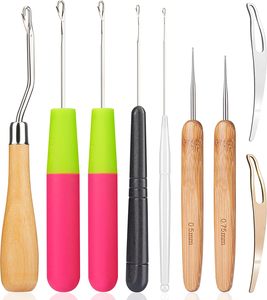
All categories
Featured selections
Trade Assurance
Buyer Central
Help Center
Get the app
Become a supplier

(3500 products available)
















































Interlock tools or locking braiding tools are a special crochet hook or tool used for braiding hair. The tool creates a braid or pattern in hair extensions or natural hair. The basic principle of interlocking is to tuck or pull a section of hair through another section to form a knot that locks the hair into place. As a result, different hairstyles, including locs, can be created. There are different kinds of interlock tools for different kinds of hair:
Interlock crochet hooks
These are small hooked tools with a pointed tip and an elongated base. They come in different sizes, materials, and colors, with or without a rubber handle. Some interlock crochet hooks have a larger hook at the end, while others have a smaller hook. The size of the hook often depends on the thickness of the hair. The smaller hook is ideal for finer hair, while the larger one works well for thicker hair. Interlock crochet hooks are made from different materials, including aluminum, steel, plastic, and bamboo. Aluminum hooks are lightweight and durable, while steel hooks have a smooth finish and are more robust. Plastic hooks are more affordable beginner-friendly, and bamboo hooks have a natural look and feel.
Locking needles
Locking needles are another tool that can be used for interlocking. When using the interlocking method for locs, a designated section of hair is pulled through the section above it and then through the section below it, creating a locking stitch. Locking needles can be used to create these locking stitches. The needle features a hook on one end, which grabs the new growth and an eye on the other end where the locs are pulled through. The needle is then pushed or pulled through the loc to create a tight knot that locks the new growth into the existing loc. This process is repeated for each section of hair to create a tight and uniform loc hairstyle.
Interlocking hair tools
Interlocking hair tools are designed for specific hairstyles, such as braids, twists, and locs. They have unique features that cater to interlocking techniques and braid formation. These tools simplify the process for stylists and individuals creating intricate loc styles or braided designs.
How to use:
To use interlock tools properly, one must first understand how to use the threading machine. The threading machine is used to create interlocked twists in the hair. Once the twists are created, the interlock tool can be used to pull the new growth into the existing locks. It is important to use the tool gently so as not to damage the locks or create excess tension.
Installation:
There is no specific installation process for interlock tools for locs. The hair must first be sectioned and twisted to form locs. Once the locs are formed, the interlock tool can be used during new growth retightening. It is important to follow a proper hair care routine to ensure the locs are maintained correctly.
Product safety:
Regarding product safety, it is essential to ensure the interlock tool is clean before use. Any dirt or bacteria on the tool can cause infection or irritation to the scalp. It is also important to use the tool in a well-lit area so as not to miss any locs or new growth sections. Proper care and handling of the tool can prevent injury or damage to the hair. It is also important to avoid using the tool on wet hair, as it can create tension and cause breakage.
Interlock tools are made with features and functions that meet the needs of interlocking nail technicians. Below are some of those features and functions:
Q1. What is the difference between interlocking and locking tools?
A1. Interlocking tools are designed to connect two or more strands of yarn or thread together, creating a secure stitch or loop. They are commonly used in crafts such as crochet or knitting to create intricate patterns and textures. On the other hand, locking tools are used to secure or fasten objects together, such as hair extensions or braids. They create a tight hold by locking two or more strands together, preventing any movement or slippage.
Q2. What is the purpose of a latch hook tool?
A2. A latch hook tool is an interlocking tool with a hinged latch that opens and closes, allowing loops of yarn or thread to be created and pulled through fabric or mesh. It is commonly used in latch hooking, a craft where small loops of yarn are made to create decorative rugs or wall hangings.
Q3. Can interlocking tools be used for hair extensions?
A3. Yes, interlocking tools can be used for hair extensions. The interlocking hair tool creates tight connections between natural hair and extensions, ensuring a seamless blend and preventing slippage.
Q4. How do I take care of my interlock tool?
A4. To care for an interlock tool, gently clean it after each use with a soft brush or cloth to remove any debris or residue. Avoid excessive force or pressure when using the tool, as this can damage the prongs or latch mechanism. Store the tool in a dry, cool place to prevent rust or corrosion, and periodically apply a small amount of oil to the moving parts to keep them lubricated and ensure smooth operation.